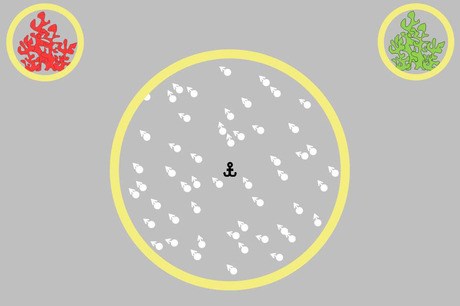New study suggests how children with autism see the world
Wednesday, May 6, 2015
Findings from new research may shed light on why children with autism experience sensory overload.

The study by the UCL Institute of Education (IOE) involved 33 children with autism and 33 children without autism and asked them to judge the average direction of a set of dots moving on a computer screen (pictured below).
In the test, the children were told the dots were fish and they had to choose whether they were swimming towards a green or red reef.
Children with autism did better at working out the overall direction of the dots when they moved in different directions.

Researcher Dr Catherine Manning from the University of Oxford, who was part of the research team, said, ‘The ability to combine motion information helps us make sense of what we see, for example, by allowing us to see the overall movement of a shoal of fish. However, it is also important to know what information needs to be filtered out. An increased combination of motion information may in some way “overload” a child with autism in a dynamic world.’
She said that the findings were not expected. ‘It’s often thought that children with autism focus on the detail and sometimes miss the bigger picture, but the results showed they could combine moving information and can even do it better than typical children do,’ she added.
However, in a separate test the children needed to ignore dots moving in random directions, and the children with autism did not do so well at this – instead they did the same as typical children.
The researchers said the results suggested that children with autism may have difficulty filtering out irrelevant information.
Dr Liz Pellicano, director of the IOE’s Centre for Research in Autism and Education (CRAE), said, ‘Our new research suggests that children with autism excel at integrating moving information – a skill that might be beneficial in some circumstances but, in others, may lead to the processing of too much unfiltered information, which could also lead to distress.’
The researchers said that their findings showed how children with autism experience the world differently.
Around one in 70 children are affected by autism and the way they perceive sensory information can impact on different areas of their lives.
Dr Manning said, ‘We know children with autism can be oversensitive or undersensitive to sensory information like light and sound, and they sometimes enjoy watching moving things – like flicking their hands in front of their eyes, or watching wheels spin on a toy car.’
She said that there was an assumption that children with autism focus on detail rather than the overall whole.
‘For example, in a forest they might focus on the individual trees, rather than the whole forest.
‘But our findings show that our understanding of autistic children as being very detailed-focused may not apply to motion information. If children with autism take everything in and don’t filter out things that are irrelevant, it may mean that they experience sensory overload.’
The researchers hope that their study will contribute to a better understanding of the condition and help to develop ways of supporting children with autism.
- ‘Enhanced integration of motion information in children with autism’ is published in the Journal of Neuroscience.




